|

Special Issue
Treasures from Banks, OR
Fall, 2004
Back to HOMEPAGE
page
1 | page 2 | page
3 | page
4 | page 5
| page 6 | page 7
|
October 17, 2004:
Found these popping up in
the gravel next to my shop. They are real heavy. 6 or 7 seven of them in
the group.
I cut three of them. They range from a white
punky center to a black punky, and a black wet gooey mess. I will keep an
eye on the rest and see what happens. Sure are lot of different things
once you start looking a bit.
More rain today
From me:
It now looks something like a
Scleroderma geaster, or Dead Man's Hand, to me. They should open up
something like an Earth Star. |
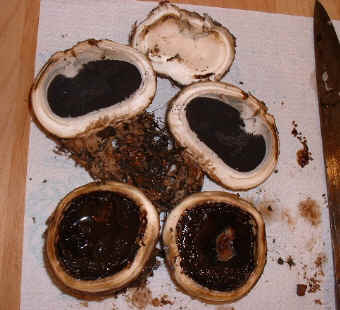
|
|
From the
Geigers,
October 21, 2004:
Herman, Rebecca found this red one today. She
looked thru all the books and can not get an ID. No gills what so ever.
Later
Bob & Rebecca
From me:
This red one looks like what is called a
"Lobster Mushroom", which is probably a Russula brevipes that
has been parasitized by the red Hypomyces lactifluorum, which eventually
removes all the gills.
The picture shown at http://botit.botany.wisc.edu/toms_fungi/aug2001.html
probably looks the most like yours.
|
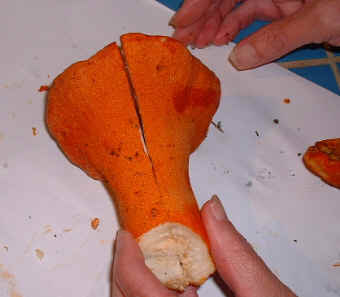
|
|
If you knew for sure which mushroom was the host, and that the host was edible, it is
edible and could be considered choice. I would say that this one is
edible if the stalk breaks like chalk, but it could be latently bitter or hot,
depending on which species of Lactarius or Russula was the host. If it
was near some R. brevipes you could try a small taste, but better safe than
sorry! Break the stalk and see if it seems like the way a brevipes breaks, or snaps. It may not though because of the hypomyces parasite. I have never seen a red hypomyces, but did once find a
Lactarius rubrilacteus parasitized by a white hypomyces, and was stumped by
the gill-less mushroom that bleed red milk. See
http://www.fungi-zette.com/mush5.htm
for Tuesday, August 17. Herman
|
|
From the
Geigers, October 23, 2004:
Good morning. Went out by the patio back of the house and found these
critters popping up. I think they are some sort of slippery jack, although
they are not real slimy, sort of moist. They do not have gills but do
have a veil. Do not blue when bruised, sort of turns brown, see photo.
The larger ones are a couple of inches across. Rebecca is taking a spore print
now.
Bob & Rebecca
From me:
I think it is a Suillus
pseudobrevipes.
I was unable to find any pictures of it on the
net, but using the key in Mushrooms Demystified, that is what I came up with.
Were they growing near a pine or spruce of some kind? The
S. pseudobrevipes are usually associated with pines or spruces, not Douglas
Fir, but that is my closest guess.
Herman
|
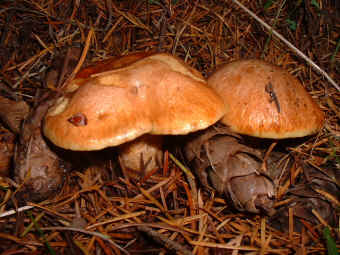
|
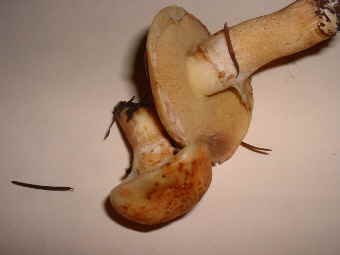
|
|
From the Geigers, October 23, 2004:
More pictures for you . Interesting.
From me:
The conk is probably a Fomitopsis
pinicola, the second small mushroom is probably a Stropharia ambigua,
and the third, string-like one is probably what is called Fairy Fingers, or Clavaria
vermicularis.
Herman
|
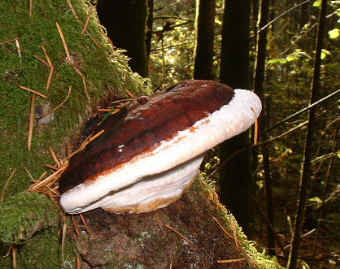
|
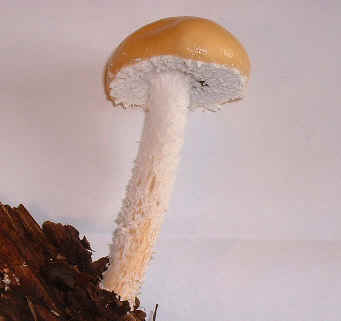 |
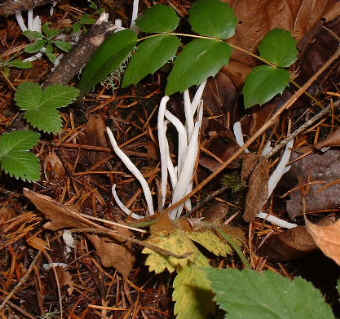
|
| From the
Geigers, October 23:
Took a short walk and took a few more pictures. I really like the digital cameras.
Bob
From me: The first one looks like a Grisette.
The second is probably the Fomitopsis pinicola again
The third is a fairy ring of some kind.
The fourth looks like two dirty Russula brevipes and a mature
puffball of some kind, unless it is going to open and show some
gills.
Any Matsutakes yet?
|
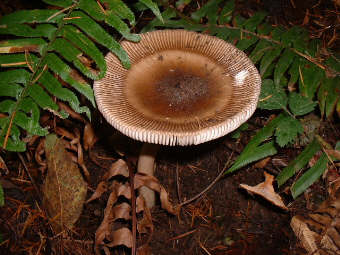 |
|

|
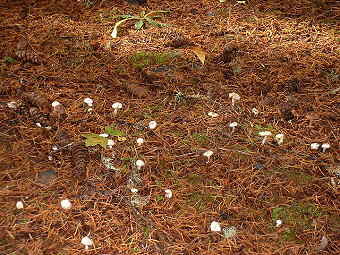
|
|
 |
|
< previous page | next
page >
Back to HOMEPAGE
|